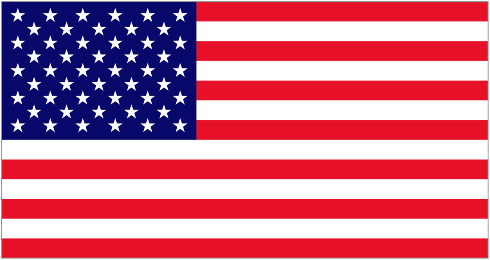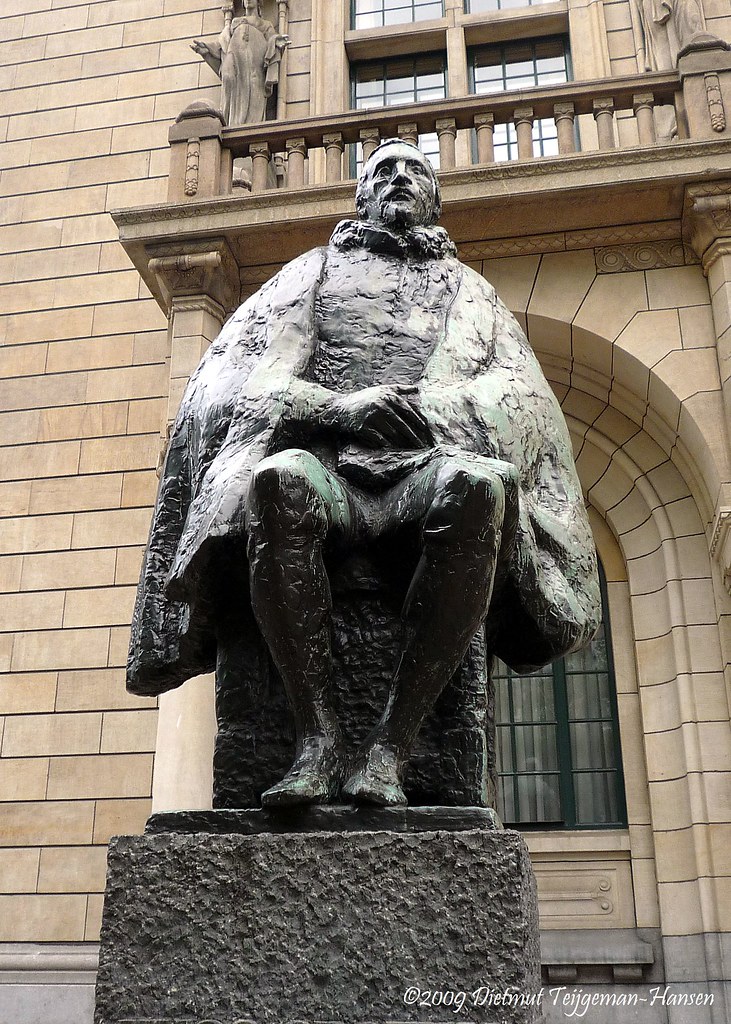

11 Monuments Related to
Hugo Grotius [1583-1645]From Wikipeida: "Hugo Grotius [1583-1645], also known as Huug de Groot, was a Dutch jurist. Along with the earlier works of [Spaniard] Francisco de Vitoria [c1483-1546] & [Italian] Alberico Gentili [1552-1508], Grotius laid the foundations for international law, based on natural law. A teenage intellectual prodigy, he was imprisoned for his involvement in the intra-Calvinist disputes of the Dutch Republic, but escaped hidden in a chest of books. He wrote most of his major works in exile in France. It is thought that Hugo Grotius was not the first to formulate the international society doctrine, but he was one of the first to define expressly the idea of one society of states, governed not by force or warfare but by actual laws & mutual agreement to enforce those laws. As Hedley Bull [1932-1985] declared in 1990: 'The idea of international society which Grotius propounded was given concrete expression in the [1648] Peace of Westphalia, and Grotius may be considered the intellectual father of this first general peace settlement of modern times.' Additionally, his contributions to Arminian theology provided the seeds for later Arminian-based movements, such as Methodism & Pentecostalism, and he is acknowledged as a significant figure in the Arminianism-Calvinism debate. Because of his theological underpinning of free trade, he is also considered an 'economic theologist.'"Click here for Grotius biography from Wikipedia.
Click here for Grotius quotations from Wikiquote.
Click here for Grotius artifacts in the Rijksmuseum, Amsterdam (Netherlands).Right click image to enlarge.
B I R T H April 10, 1583 - Born 10 April in Delft, Holland (Dutch Republic).
1599 - Portrait of Hugo Grotius at age 16 by Jan Antonisz. van Ravesteyn (Netherlands). Where is this painting today?
1608 - Portrait of Hugo Grotius at age 25 by Michiel Jansz. van Mierevelt (Netherlands). Where is this painting today?



1621? - Book chest in which Grotius escaped in 1621, Rijksmuseum, Amsterdam (Netherlands). From Wikipedia: "Hugo Grotius [1583-1645] was a Dutch jurist. Along with the earlier works of [Spaniard] Francisco de Vitoria [c1483-1546] & [Italian] Alberico Gentili [1552-1508], Grotius laid the foundations for international law, based on natural law. A teenage intellectual prodigy, he was imprisoned for his involvement in the intra-Calvinist disputes of the Dutch Republic & imprisoned in Slot Loevestein / Loevestein Castle but escaped hidden in a chest of books. He wrote most of his major works in exile in France."In 1621, with the help of his wife & his maidservant, Elsje van Houwening, Grotius managed to escape the castle in a book chest & fled to Paris. In the Netherlands today, he is mainly famous for this daring escape. Both the Rijksmuseum in Amsterdam & the Museum Het Prinsenhof in Delft claim to have the original book chest in their collection."
B O O K 1625 - De jure belli ac pacis / On the Law of War and Peace" is a 1625 book in Latin, written by Hugo Grotius & published in Paris (France), on the legal status of war. It is now regarded as a foundational work in international law.
1631 - Portrait of Hugo Grotius by Michiel Jansz. van Mierevelt, Rijksmuseum, Amsterdam (Netherlands). "When De Groot returned to the Netherlands in 1631, he hoped he would be left in peace. However, he was threatened with arrest again six months later and left for good."
D E A T H August 28, 1645 - Died (aged 62) in Rostock (Swedish Pomerania). Buried in Nieuwe Kerk/New Church, Delft (Netherlands).

Diary entry by Bertha von Suttner [1843-1914]: "Today [July 4, 1899], in connection with the American holiday, an excursion to Delft in commemoration of Grotius. In the early morning a severe storm is raging and rain is beating on the windowpanes. We countermand our order for a carriage and stay at home [i.e. in the Kurhaus on the beach in Scheveningen]." /// Note from Conference President de Staal [1822-1907]: House in the Woods, July 5, 1899. "Dear Baroness von Suttner, We were very sorry not to see you and the Baron at Delft, but we fully understood and appreciatred the reason. We really did not expect more than a dozen or twenty people, and were greatly surprised to see so large a number present. It was to me very inspiring and gave me new hopes as to the results of the Conference..."



W
R
E
A
T
HJuly 4, 1899 - Silver Wreath on Tomb of Hugo Grotius [1583-1645], Nieuwe Kerk/New Church, Delft (Netherlands). Laid by US delegation to the 1899 Hague Peace Conference. Inscribed in English: "To the Memory of Hugo Grotius / In Reverence and Gratitude / From the United States of America / on the occasion of the International Peace Conference in The Hague / July 4, 1899." Right image shows Dr. Arthur Eyffinger (author of numerous books on The Hague & Peace Palace) & American professor Hope Elizabeth May who cleaned the wreath for the first time in 113 years & caused it to be rededicated on July 4, 2012. Left & middle images are from an 1899 book which Prof. May found at the US Library of Congress. Click here for video of the rededication. All images & info courtesy of Prof. May 07Feb13.



1913 - Grotius Window, Peter J. Gomes Chapel, Bates College, 275 College Street, Lewiston, Maine (USA). "The chapel is heavily influenced by the Gothic construction that came from the King’s College Chapel of University of Cambridge, which was built in the 15th century by Henry VI of England... The stained glass windows that line the nave contain mostly secular figures whose scholarly & artistic endeavors have contributed to society & culture."
Date? - Grotius College, Delft (Netherlands).

August 25, 1931 - Stained Glass Window, Nieuwe Kerk/New Church, Delft (Netherlands). "Depicts the life story of Hugo Grotius in 14 scenes. Offered by the Dutch-American Foundation in celebration of the 300th anniversary of Grotius’ ‘De Jure belli ac pacis / On the Law of War & Peace.' Artist is Joep Nicolas [1898-1972] [who obtained American nationality in 1953]. Funds for the window were raised by the US legal community including the American Bar Association. Unveiled by American Jurist Frank B. Kellogg [1856-1937] who, two years prior, won the Nobel Peace Prize. Kellogg was co-author of the Kellogg-Briand Pact (signed August 27, 1928, outlawing war as a means of national policy). He also served on the Permanent Court of International Justice [in The Hague]." Information & image courtesy of Prof. Hope Elizabeth May 23July2017.





1932-1952 - "New World Window," First Congregational Church, Los Angeles, California (USA). "By the Judson Studios of Pasadena... At the top are the Statesmen: Hugo Grotius, who proclaimed the freedom of the seas, Winston Churchill, who would defend freedom with blood, sweat and tears; and Woodrow Wilson, whose ideal was to secure freedom by international brotherhood. This window depicts New World personages outstanding in the fields of science literature, law, medicine, and men of purpose who have used their abilities to serve God and Men." Information & image courtesy of Katie Pegelow.



1950 - Marble relief portrait of Hugo Grotius, US Capitol, Washington, DC (USA). "Marble 28" in diameter by C. Paul Jennewein. Over the gallery doors of the House Chamber. [This & 22 other] marble relief portraits depict historical figures noted for their work in establishing the principles that underlie American law. They were installed when the chamber was remodeled in 1949-1950."


October 27, 1970 - Standbeeld van Hugo de Groot / Statue of Hugo Grotius, City Hall, Rotterdam (Netherlands). Statue sculpted by Auke Hettema [1927-2004]. Texts on the pedestal are partly in Latin & partly in Dutch. From Wikipedia: "Hugo Grotius [1583-1645] was a Dutch jurist. Along with the earlier works of [Spaniard] Francisco de Vitoria [c1483-1546] & [Italian] Alberico Gentili [1552-1508], Grotius laid the foundations for international law, based on natural law. A teenage intellectual prodigy, he was imprisoned for his involvement in the intra-Calvinist disputes of the Dutch Republic & imprisoned in Slot Loevestein / Loevestein Castle but escaped hidden in a chest of books [see Amsterdam above]. He wrote most of his major works in exile in France." Information courtsy of Petra Keppler 20July2017 & Peter van den Dungen 23July2017.
END OF GROTIUS FILE



